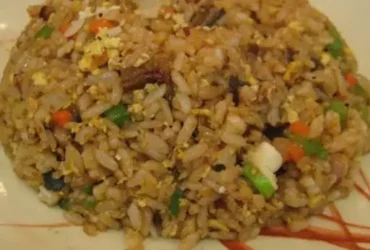Ingredients
Firm Tofu: 1 block (14 oz)
Firm tofu is a staple ingredient in many plant-based recipes, including our baked tofu recipe. To use firm tofu in this recipe, you will need to start by purchasing a block that is 14 oz in weight.
The firmness of the tofu is key when choosing the right product for this recipe. Firm tofu has a denser and chewier texture compared to soft or silken tofu, which makes it perfect for baking.
A 14 oz block of firm tofu will provide you with enough material to cut into slices or cubes that can be baked in the oven until crispy on the outside and tender on the inside.
Firm tofu is typically made from soybeans and has a neutral flavor, making it an excellent base for many different seasonings and marinades. To ensure that your tofu turns out perfectly in this recipe, make sure to press it before cutting it into the desired shape.
Pressing the tofu helps remove excess liquid, which can prevent it from browning evenly in the oven. You can use a tofu press or wrap the tofu in a clean kitchen towel and place a plate on top of it to apply pressure.
Once you have pressed and cut your firm tofu into the desired shape, you can proceed with marinating it and baking it according to our recipe instructions.
Cornstarch: 1/4 cup
Cornstarch is a crucial ingredient in many Asian-style baked tofu recipes, and its use can greatly enhance the texture and flavor of the dish.
In this particular recipe, we are using _1/4 cup_ of cornstarch as one of our key ingredients. Cornstarch is derived from the endosperm of the corn kernel and is commonly used as a thickening agent in cooking.
The role of cornstarch in this recipe is twofold. Firstly, it helps to create a crispy exterior on the baked tofu by forming a crunchy layer of starch when cooked. This textural element adds depth and interest to each bite.
Secondly, the cornstarch mixture also serves as a marinade for the tofu. It helps to absorb flavors from other ingredients such as soy sauce, maple syrup, and spices, which are then evenly distributed throughout the tofu during baking.
The cornstarch absorbs excess moisture from the tofu and helps it brown more evenly in the oven. This browning process is key in creating a visually appealing dish with a satisfying texture.
In terms of flavor, cornstarch can also contribute to the overall taste profile of the recipe by providing a subtle sweetness and starchy undertone that complements other ingredients such as soy sauce and spices.
Overall, the use of 1/4 cup of cornstarch in this baked tofu recipe plays a significant role in enhancing both the texture and flavor of the dish. It’s an essential ingredient to include for anyone looking to create a delicious and authentic Asian-style baked tofu experience.
Soy Sauce: 2 tbsp
Soy sauce is a fundamental ingredient in many Asian cuisines, particularly when it comes to marinating and flavoring proteins like tofu.
The two tablespoons of soy sauce called for in this Baked Tofu recipe will provide a rich, savory umami flavor that complements the other ingredients perfectly.
Soy sauce is typically made from fermented soybeans, salt, and water, with some recipes also including additional ingredients like rice or wheat.
The fermentation process gives soy sauce its distinct taste, which is often described as a combination of savory, sweet, and salty flavors.
In the context of this Baked Tofu recipe, the soy sauce helps to enhance the natural flavor of the tofu while also adding depth and complexity to the dish.
The two tablespoons of soy sauce are an essential component of the marinade, which also includes other key ingredients like maple syrup and garlic powder.
Together, these ingredients work in harmony to create a delicious and savory flavor profile that is sure to please even the most discerning palates.
Rice Vinegar: 2 tbsp
Rice vinegar is a staple ingredient in many Asian cuisines, and it plays a crucial role in adding depth and balance to the flavors of our Baked Tofu Recipe.
In this recipe, we are using 2 tablespoons of rice vinegar, which serves several purposes:
- Adds a sour flavor: Rice vinegar is acidic in nature, and it helps to cut through the richness of the tofu and the other ingredients. It adds a bright and refreshing note to the dish.
- Helps to balance flavors: The acidity in rice vinegar also helps to balance out the sweetness from the sugar and the savory flavor from the soy sauce. This ensures that no single ingredient overpowers the others.
- Enhances umami flavor: Rice vinegar contains glutamates, which are amino acids that are responsible for the umami taste. This enhances the overall depth of flavor in the dish and adds a meaty, savory quality to the tofu.
Rice vinegar is made from fermented rice, and it has a light, delicate flavor that is similar to apple cider vinegar but with a more subtle sweetness. It’s a versatile ingredient that can be used in a variety of dishes, from stir-fries and marinades to dressings and sauces.
In the context of our Baked Tofu Recipe, the 2 tablespoons of rice vinegar are combined with other ingredients like soy sauce, maple syrup, and sesame oil to create a sweet, savory, and umami-rich glaze that coats the tofu evenly. This adds flavor and moisture to the tofu without making it too heavy or overpowering.
Maple Syrup: 2 tsp
Tofu plays a starring role in this vegan baked tofu recipe, and it’s the perfect combination of savory flavors and textures that makes this dish so compelling.
The ingredients we’ll be using are listed below:
1 block of extra-firm tofu, drained and pressed
Main flavor components:
- Soy sauce – 2 tbsp (to give the dish a savory depth)
- Rice vinegar – 2 tbsp (for a slightly acidic bite)
- Maple syrup – 2 tsp (for a touch of sweetness to balance out the flavors)
Aromatics:
- Freshly ground black pepper (to add a bit of heat)
- Minced garlic – 1 tsp (for an added punch of flavor)
Herbs:
- Dried oregano (optional, for an earthy depth)
- Chopped fresh rosemary (optional, for a herbaceous note)
In addition to the ingredients above, you’ll also want to have some neutral-tasting oil on hand, like canola or grapeseed oil.
Before we move on to the instructions, take a moment to review the list of ingredients and make sure you have everything you need on hand.
Instructions
Preheat Oven and Prep Tofu
To begin with, it’s essential to follow a series of instructions when preparing a Baked Tofu Recipe. These steps will guide you through preheating your oven and prepping the tofu for baking.
Step 1: Preheat Oven
The first step in this process is to preheat your oven to the desired temperature. For a standard baked tofu recipe, preheat the oven to 400°F (200°C). This will ensure that your oven reaches its optimal temperature and is ready for baking.
- Select the right temperature setting: Choose the correct temperature setting on your oven based on the recipe requirements.
- Set the timer: Set a timer according to the cooking time specified in the recipe. This will help you keep track of the baking time and prevent overcooking or undercooking.
Step 2: Prep Tofu
Before placing the tofu in the oven, it’s essential to prep it for baking. Here are a few steps you can follow:
- Drain excess liquid: Remove any excess liquid from the tofu by wrapping it in a paper towel or clean cloth. This will help remove excess moisture and prevent a soggy texture.
- Cut into desired shape: Cut the tofu into your desired shape or size, based on the recipe requirements.
Once you’ve completed these steps, your oven is preheated, and the tofu is prepped for baking. You can now proceed with seasoning the tofu and placing it in the oven according to the recipe instructions.
The first step in following instructions for a recipe, such as baking tofu, is to gather all necessary ingredients and equipment beforehand.
This includes having the appropriate type and amount of tofu, seasonings, cooking oil, baking sheets or pans, oven, and any additional utensils required for preparation and serving.
Before beginning, it’s also crucial to read through the recipe carefully, taking note of all measurements and steps involved in preparing the dish.
This ensures that you’re aware of any special requirements, such as marinating or pressing the tofu before cooking, and can plan accordingly.
Once all necessary ingredients are ready, follow the recipe’s instructions for preparation and cooking.
This may involve marinating or seasoning the tofu, preheating the oven to the specified temperature, placing the tofu on a baking sheet lined with parchment paper, and drizzling it with oil.
Bake the tofu in the oven according to the specified time frame, usually 15-20 minutes for cubed tofu, or until golden brown on all sides and crispy at the edges.
Remove the tofu from the oven once cooked and carefully transfer it to a serving plate or dish.
Serve the baked tofu hot, garnished with chopped herbs or scallions if desired, and accompanied by your choice of side dishes or sauces for added flavor.
The key to following instructions effectively is attention to detail and patience in completing each step.
Precise temperature for baking is 400°F (200°C). Ensure oven is preheated accordingly.
Baking tofu to perfection requires attention to detail and precision, particularly when it comes to temperature control. The ideal temperature for baking tofu is 400°F (200°C), which should be reached by preheating the oven accordingly. This precise temperature allows for even cooking, prevents overcooking or undercooking of the tofu, and enhances its texture.
Preheating the oven to the correct temperature is essential for achieving the desired results in baked tofu. To ensure that your oven has reached the right temperature, you can use an oven thermometer. This will provide accurate readings and give you peace of mind knowing that your oven is at the optimal temperature for baking tofu.
When preparing the tofu for baking, it’s essential to remove any excess liquid by wrapping it in a clean dish towel or paper towels. This helps to absorb any remaining moisture, allowing for better browning and crisping during the baking process. Additionally, you can press the tofu gently between two plates or cutting boards to remove additional liquid.
Once your oven has reached 400°F (200°C), place the prepared tofu on a baking sheet lined with parchment paper or a silicone mat. This will prevent sticking and make cleanup easier. Drizzle any desired seasonings, sauces, or oils over the tofu before placing it in the preheated oven.
The baking time for tofu can vary depending on its size, thickness, and your personal preference for texture and doneness. As a general guideline, bake the tofu for 20-25 minutes, turning it occasionally to ensure even cooking. You can check for doneness by cutting into one of the blocks; if it’s firm, golden brown, and has a crispy exterior, it’s ready.
Remember to keep an eye on your oven temperature throughout the baking process and adjust as needed. With practice and experience, you’ll become more confident in your ability to achieve perfectly baked tofu every time.
Beyond achieving the ideal temperature, precision is key when preparing other ingredients for the baked tofu recipe. Pay attention to ingredient ratios, cooking times, and oven temperatures to ensure that all components are prepared correctly and harmonize together in the final dish.
Wrap the block of tofu in a clean kitchen towel or paper towels. This step helps remove excess moisture, leading to better texture during baking.
In order to achieve the best results from a baked tofu recipe, it’s essential to prepare the tofu properly before baking. One crucial step in this process is wrapping the block of tofu in a clean kitchen towel or paper towels.
This step may seem simple, but its significance cannot be overstated. When you wrap the tofu in a clean kitchen towel or paper towels, you are helping to remove excess moisture from the surface of the tofu.
The presence of excess moisture can hinder the texture and appearance of your baked tofu. By removing it, you allow the tofu to absorb flavors and seasonings more evenly and efficiently.
When wrapping the tofu in a clean kitchen towel or paper towels, make sure to cover all surfaces evenly, including the top and bottom of the block. This will ensure that moisture is removed from every angle, resulting in better texture during baking.
The use of a kitchen towel or paper towels serves as an additional layer between the tofu and any air within the wrapping material. This prevents air pockets from forming and causing uneven drying, which can lead to a less-than-desirable outcome in your baked tofu.
It’s also worth noting that you should wrap the tofu gently but firmly to ensure that it remains secure throughout the baking process. This will prevent any accidental displacement of the wrapping material or the tofu itself during baking.
In summary, wrapping the block of tofu in a clean kitchen towel or paper towels is an essential step in preparing it for baking. By following this simple yet crucial instruction, you can ensure that your baked tofu turns out with excellent texture and appearance.
The art of creating a successful baked tofu recipe lies not just in the ingredients or the technique, but in the instructions provided to guide the cook through each step.
Clear and concise instructions are essential for ensuring that the end product meets expectations.
When writing instructions, it’s crucial to consider the audience – in this case, a home cook following a baked tofu recipe.
The language used should be accessible and easy to understand, avoiding technical jargon or complex terminology that might confuse or intimidate the reader.
A good set of instructions will break down the task into manageable steps, providing specific details about what needs to be done at each stage.
This might include information on preparation (e.g., draining excess liquid from the tofu), temperature and baking time, and any necessary adjustments for a particular oven or environment.
The order in which tasks are presented can also impact the overall success of the recipe – typically, preparing ingredients comes before cooking, but specific instructions may vary depending on the dish.
Accompanying visual aids such as photographs or diagrams can help to clarify complex steps and provide an additional layer of guidance for cooks who struggle with written explanations.
In addition to clear language and step-by-step directions, it’s also important to include contextual information that helps the cook understand what they are doing and why.
This might involve explaining the purpose or history behind a particular ingredient or technique, providing suggestions for variations or substitutions, and offering troubleshooting tips for common issues that may arise during the cooking process.
Serving and Variations
Tofu Baking Tips
Serving baked tofu can be just as creative and delicious as the dish itself. Here are some tips on serving and variations to take your baked tofu to the next level:
First, consider the temperature at which you serve your baked tofu. Warm temperatures can enhance the flavors of the dish, while a cold serving option can provide a refreshing contrast. Experiment with both options to find your preference.
Add some crunch to your baked tofu by sprinkling chopped nuts or seeds on top before serving. This adds texture and flavor, creating an engaging dining experience for your guests.
Combine your baked tofu with other Asian-inspired ingredients like stir-fried vegetables, pickled ginger, and wasabi sauce for a harmonious balance of flavors.
Create a Mediterranean twist by pairing the baked tofu with hummus, tabbouleh salad, or grilled lemon slices. The result is a delicious blend of East meets West cuisine.
Another approach to serving baked tofu is to incorporate it into salads. A simple green salad, mixed berry salad, or even quinoa salad can benefit from the addition of protein-rich baked tofu.
To make your baked tofu recipe even more appealing, try incorporating different seasonings and spices in various stages during the preparation process. For example, marinating the tofu before baking, adding herbs like thyme or rosemary while it’s cooking, or drizzling a sauce after serving can all enhance the flavor profile.
Lastly, remember that presentation matters when serving baked tofu. Arrange sliced vegetables and fruits artfully on your plate to create an appealing visual display. This not only adds ambiance but also makes for an enjoyable dining experience.
For baking tofu at home, here are some general tips:
To prevent sticking, pat the excess moisture off the tofu with a clean kitchen towel or paper towels before placing it on the baking sheet. This will help your baked tofu brown more evenly and evenly distribute heat.
Brushing the tofu lightly with oil can also aid in browning and crisping up the exterior during cooking.
Avoid overcrowding your baking sheets as this can cause the tofu to steam instead of bake, resulting in an unpleasant texture. Bake individual pieces or use a larger baking sheet if necessary to ensure even cooking space.
Experiment with various marinades for different flavor profiles, from soy sauce and ginger to lemon juice and herbs. This allows you to adjust the seasoning according to your personal taste preferences and desired outcome.
Consider using parchment paper on your baking sheets as this helps prevent the tofu from sticking and makes cleanup easier.
Baking at a moderate temperature (around 375-400°F) can help achieve a crispy exterior without overcooking the interior. Keep an eye on your baked tofu, however, to ensure it reaches your desired level of browning.
The University of California suggests that baking is an excellent method for preparing tofu due to its ability to maintain protein structure without adding extra oil or fat. To take it up a notch, consider marinating the tofu before baking.
Taking your baked tofu to the next level involves understanding the concept of serving and variations, as suggested by The University of California. According to their research, baking is an efficient method for preparing tofu because it can maintain its protein structure without adding extra oil or fat. To enhance this process even more, consider marinating the tofu before baking.
This step adds a layer of flavor and tenderness to the tofu that would otherwise be absent from a plain baked tofu recipe. Marinating typically involves soaking the tofu in a mixture of seasonings, herbs, and sometimes acidic ingredients like vinegar or lemon juice, for a period ranging from 30 minutes to several hours.
The key to successful marination is to allow the tofu sufficient time to absorb the flavors and moisture from the marinade. A general rule of thumb is to plan at least an hour of marinating time per pound of tofu. However, this timeframe can be adjusted based on personal preference and the intensity of the marinade.
When it comes to choosing a marinade for your tofu, there are countless options available, each offering a unique blend of flavors and textures. Some common types of marinades include Italian-style with garlic and herbs, Indian-inspired with spices like cumin and coriander, or Asian-fusion with soy sauce and ginger.
The beauty of marinating lies in its versatility – you can experiment with different combinations of ingredients to create a marinade that suits your taste preferences. For example, if you’re looking for a lighter, fresher flavor, try using olive oil, lemon juice, and chopped herbs like parsley or basil.
In terms of actual preparation, the marinating process is relatively straightforward: simply place the tofu in a container large enough to hold it flat, pour over the marinade, cover the container with plastic wrap or a lid, and refrigerate. After the marination period has elapsed, remove the tofu from the fridge, pat it dry with paper towels to remove excess moisture, and proceed with baking.
By incorporating this extra step into your baked tofu recipe, you’ll be able to create a dish that’s not only nutritious but also incredibly flavorful and visually appealing. The marinating process helps break down the proteins in the tofu, making it more tender and easier to digest, which is especially beneficial for individuals with sensitive stomachs or dietary restrictions.
- Best LeadsGorilla Alternatives for 2025 - April 22, 2025
- Best Leadzai Alternatives for 2025 - April 22, 2025
- Best LeadSwift Alternatives for 2025 - April 21, 2025












